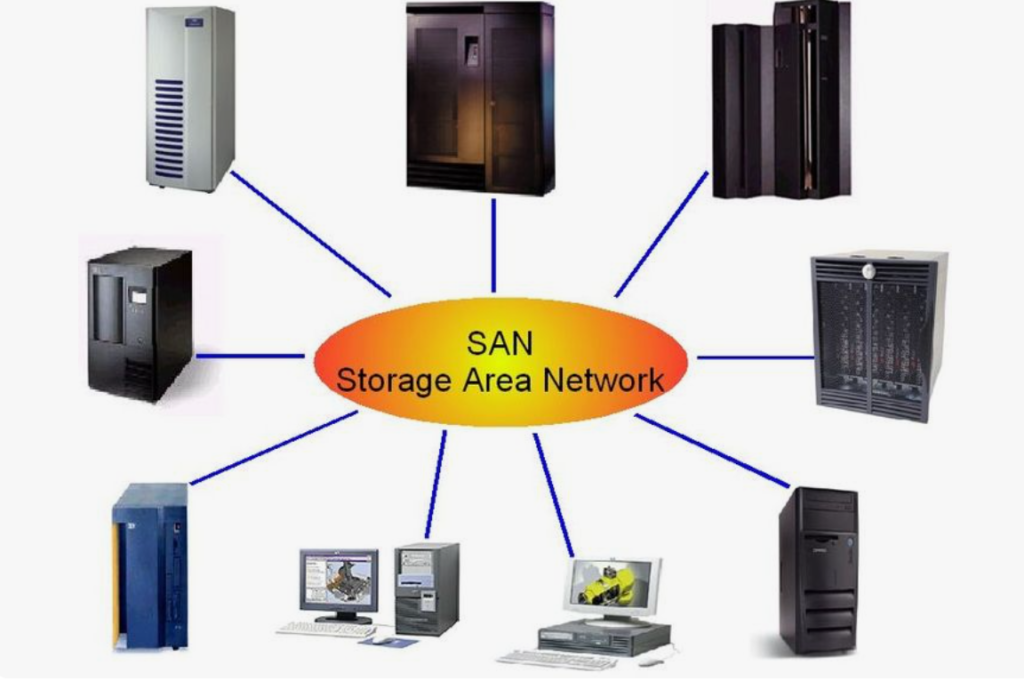
How Storage Area Networks Simplify Complex Data Environments
Running a business in today’s digital world means dealing with a mountain of data that seems to grow every day. Managing all this information without the right tools can become a daunting task,
but what if there was a way to streamline it all?
Upgrade to Storage Area Networks (SAN), the game-changing solution that can transform how your business handles data.
SAN is designed to simplify the complexities of managing large amounts of data by providing a centralized, high-speed, and secure storage solution.
You will be surprised to know about the recent numbers of SAN as one of the reports mentions:
The global Storage Area Network (SAN) market was valued at approximately USD 17.46 billion in 2023. It is projected to grow steadily and reach an estimated USD 25.48 billion by 2030.
By making data storage and access more efficient, SAN allows businesses to focus on what truly matters: growth and innovation.
Let’s explore how SAN takes the stress out of data management and why it’s a must-have for modern businesses.
Simplifying Data Management and Access
Managing data in a large organization can be tricky. Multiple departments, countless files, and huge amounts of information can lead to confusion and inefficiency. SAN storage simplifies this by providing a centralized and organized way to manage all the data.
Here’s how SAN helps:
- Centralized storage: Instead of storing data across various servers or devices, SAN centralizes all data storage. This means all information is stored in one place, making it easier to manage and protect.
- Faster data access: Since SAN is built for high-speed data transfer, it makes accessing and retrieving files faster. This ensures employees can quickly access the data they need without delays.
Increasing Efficiency in Data Handling
As businesses grow, data volume increases. A complex data environment often leads to slower performance and higher chances of data loss or corruption. SAN eliminates many of these issues by improving data handling efficiency. It ensures that data is always accessible and well-organized, even during peak usage times.
Here are a few ways SAN improves efficiency:
- Load balancing: SAN can distribute workloads across multiple storage devices, preventing any single device from being overloaded. This leads to more efficient use of resources and better performance.
- Easy scalability: As your business grows, you’ll need more storage. SAN makes it easy to scale up storage capacity without disruption. You can add new devices to the network without needing to reconfigure everything.
Improving Data Protection and Backup
Do you know?
The global data protection market was valued at USD 131.82 billion in 2023 and is projected to grow from USD 150.38 billion in 2024 to USD 505.98 billion by 2032.
When it comes to data, security and reliability are everything. A complex data environment without the right safeguards can leave businesses vulnerable to data loss or breaches. This is where SAN storage shines by providing advanced data protection features.
SAN helps in Data Protection:
- Data redundancy: SAN can create copies of data, ensuring there are backup copies available if something goes wrong. This means your data is safe even if a device fails.
- Automated backups: SAN systems often have automated backup features that ensure your data is regularly backed up without manual intervention. This reduces the chances of losing important information.
By using SAN, businesses get peace of mind knowing their data is secure and protected. Even if a disaster strikes, they can recover quickly and minimize downtime.
Enhancing Performance with SAN
One of the major challenges in a complex data environment is ensuring high performance while handling large amounts of data. Slow data transfers and bottlenecks can cause delays and reduce productivity.
Here’s how SAN enhances performance:
- Dedicated bandwidth: Since SAN operates on a separate network, it doesn’t compete with other business network traffic. This ensures that data transfers happen at high speeds with minimal latency.
- Optimized storage usage: SAN optimizes storage by grouping and managing data more efficiently. This ensures that you’re using your storage devices to their full potential, reducing wasted space and increasing the overall performance of the system.
With SAN, businesses can achieve lightning-fast data access and maintain smooth operations, no matter how complex the data environment is.
Streamlining Disaster Recovery and Continuity
Every business should have a plan in place for disaster recovery. Losing data due to natural disasters, cyberattacks, or technical failures can be catastrophic. SAN simplifies disaster recovery by offering features that ensure business continuity even when the unexpected happens.
Here’s how SAN helps with disaster recovery:
- Remote replication: SAN allows you to replicate data to remote locations, ensuring that a backup is available if the primary storage site experiences a failure.
- Snapshot technology: SAN can take regular snapshots of your data, allowing you to roll back to a previous point in time in case of data corruption or loss.
These features ensure that businesses can quickly recover from disasters and continue to operate without significant disruption. Having a robust disaster recovery system in place can save time, money, and reputation in the long run.
Reducing Complexity in Data Environments
A major challenge in large organizations is the complexity of managing multiple storage systems and devices. Traditional storage methods require managing different types of storage for servers, databases, and other applications. SAN simplifies this by consolidating everything into a single network, reducing the overall complexity.
SAN reduces complexity:
- Unified management: With SAN, businesses can manage their entire storage system from one centralized platform. This makes it easier to monitor performance, allocate resources, and track storage usage.
- Simplified upgrades: When it’s time to upgrade your storage system, SAN makes the process simpler by allowing businesses to add more storage without disrupting ongoing operations.
By reducing complexity, SAN helps businesses focus on what really matters—running their operations smoothly and efficiently.
Conclusion
Storage Area Networks (SAN) are a powerful solution for businesses that need to simplify complex data environments. By centralizing storage, improving data protection, increasing efficiency, and enhancing performance, SAN provides a seamless and reliable infrastructure for managing growing data demands.
So, if you’re dealing with complex data environments and looking for a way to simplify operations, consider how SAN can make your storage management easier, faster, and more reliable. With SAN in place, you’ll be ready to handle the data demands of today and the future.
Also read: Top 8 Rack Server Installation Tips You Need to Know






